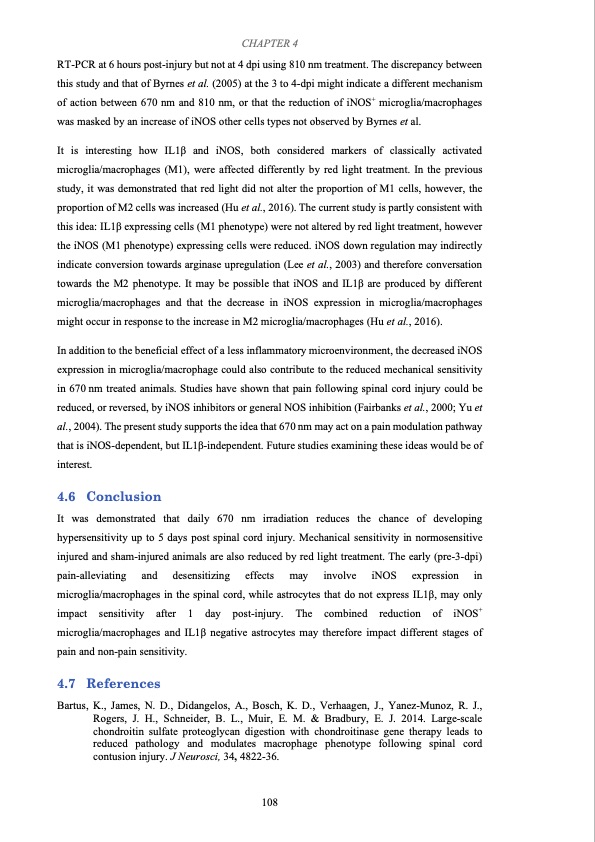
PDF Publication Title:
Text from PDF Page: 122
CHAPTER 4 RT-PCR at 6 hours post-injury but not at 4 dpi using 810 nm treatment. The discrepancy between this study and that of Byrnes et al. (2005) at the 3 to 4-dpi might indicate a different mechanism of action between 670 nm and 810 nm, or that the reduction of iNOS+ microglia/macrophages was masked by an increase of iNOS other cells types not observed by Byrnes et al. It is interesting how IL1β and iNOS, both considered markers of classically activated microglia/macrophages (M1), were affected differently by red light treatment. In the previous study, it was demonstrated that red light did not alter the proportion of M1 cells, however, the proportion of M2 cells was increased (Hu et al., 2016). The current study is partly consistent with this idea: IL1β expressing cells (M1 phenotype) were not altered by red light treatment, however the iNOS (M1 phenotype) expressing cells were reduced. iNOS down regulation may indirectly indicate conversion towards arginase upregulation (Lee et al., 2003) and therefore conversation towards the M2 phenotype. It may be possible that iNOS and IL1β are produced by different microglia/macrophages and that the decrease in iNOS expression in microglia/macrophages might occur in response to the increase in M2 microglia/macrophages (Hu et al., 2016). In addition to the beneficial effect of a less inflammatory microenvironment, the decreased iNOS expression in microglia/macrophage could also contribute to the reduced mechanical sensitivity in 670 nm treated animals. Studies have shown that pain following spinal cord injury could be reduced, or reversed, by iNOS inhibitors or general NOS inhibition (Fairbanks et al., 2000; Yu et al., 2004). The present study supports the idea that 670 nm may act on a pain modulation pathway that is iNOS-dependent, but IL1β-independent. Future studies examining these ideas would be of interest. 4.6 Conclusion It was demonstrated that daily 670 nm irradiation reduces the chance of developing hypersensitivity up to 5 days post spinal cord injury. Mechanical sensitivity in normosensitive injured and sham-injured animals are also reduced by red light treatment. The early (pre-3-dpi) pain-alleviating and desensitizing effects may involve iNOS expression in microglia/macrophages in the spinal cord, while astrocytes that do not express IL1β, may only impact sensitivity after 1 day post-injury. The combined reduction of iNOS+ microglia/macrophages and IL1β negative astrocytes may therefore impact different stages of pain and non-pain sensitivity. 4.7 References Bartus, K., James, N. D., Didangelos, A., Bosch, K. D., Verhaagen, J., Yanez-Munoz, R. J., Rogers, J. H., Schneider, B. L., Muir, E. M. & Bradbury, E. J. 2014. Large-scale chondroitin sulfate proteoglycan digestion with chondroitinase gene therapy leads to reduced pathology and modulates macrophage phenotype following spinal cord contusion injury. J Neurosci, 34, 4822-36. 108PDF Image | Effects of Red Light Treatment on Spinal Cord Injury

PDF Search Title:
Effects of Red Light Treatment on Spinal Cord InjuryOriginal File Name Searched:
Thesis_Di Hu_final.pdfDIY PDF Search: Google It | Yahoo | Bing
Cruise Ship Reviews | Luxury Resort | Jet | Yacht | and Travel Tech More Info
Cruising Review Topics and Articles More Info
Software based on Filemaker for the travel industry More Info
The Burgenstock Resort: Reviews on CruisingReview website... More Info
Resort Reviews: World Class resorts... More Info
The Riffelalp Resort: Reviews on CruisingReview website... More Info
| CONTACT TEL: 608-238-6001 Email: greg@cruisingreview.com | RSS | AMP |